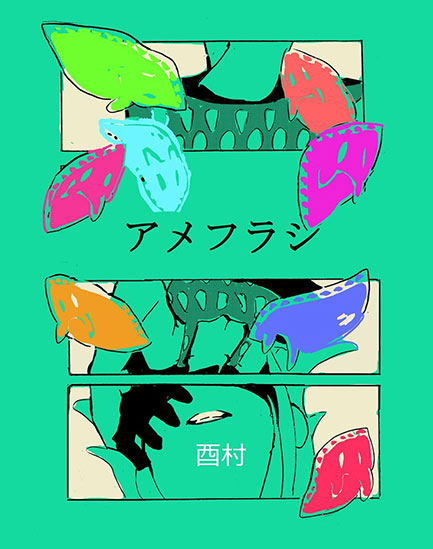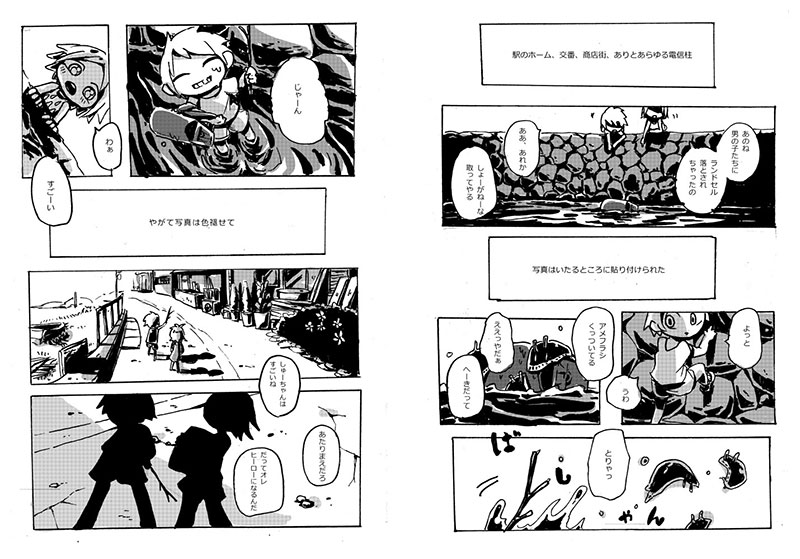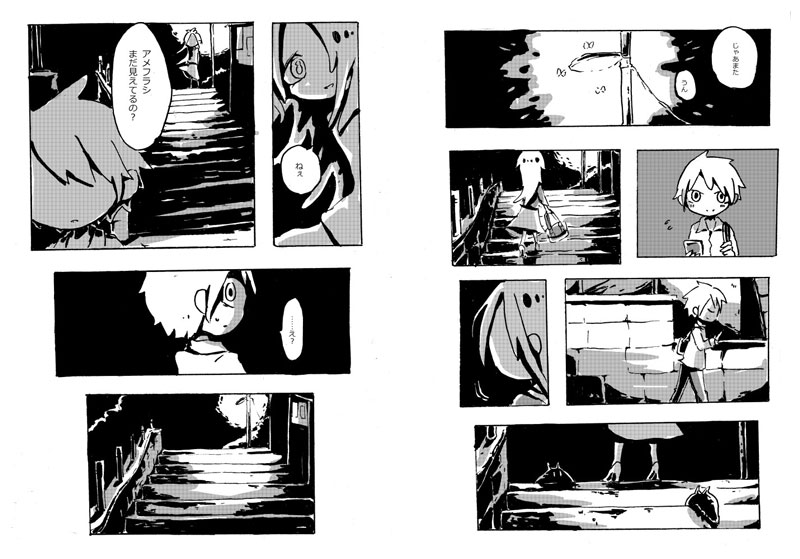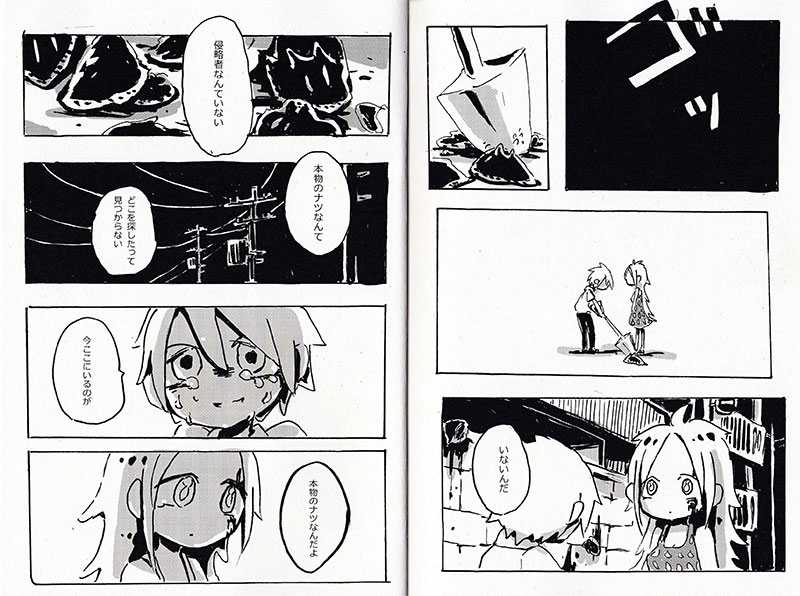Finally, I’m back to introducing you to doujinshi I enjoyed. Life has been busy, so it’s been two months again…
Amefurashi by Torimura (circle: Daiouika)
WARNING: This book is about sexual abuse of a child. If you’re squeamish about these things (and I don’t blame you if you are), please stop reading. I will not post scans of the scenes in question, but the subject matter is pretty jarring, so be warned.
There was a girl I liked. One day, her photograph was posted all over our town.
In the railway station, the police box, the shopping center, and lamp posts all over the place…
The flyer was everywhere.
After a while, the colors started to fade.
The paper got wet, torn, blown away by the wind. People would punch in holes with push pins.
Now, ten years later, nobody remembers her face.
These are the words of the opening narration of Amefurashi, accompanying scenes of a young boy helping a girl reclaim her school backpack from a creek some bullies had chucked it in. They laugh, and the girl, as little girls do, proclaims that she will marry the boy.
At the end of this prologue, the girl is pulled into a van and disappears, leaving the boy standing helplessly in the middle of the road.
Cut to the present, the boy, now in his late teens, is a kitchen help at a family restaurant. His colleagues mention a pretty customer he should check out, and there she is – his childhood friend Natsu, who vanished all those years ago. She recognizes the understandably shellshocked protagonist (Referred to only as “Shu-chan”), and they rekindle their friendship and budding romance.
One evening, as they revisit a playground they frequented as children, Natsu reveals to the protagonist what happened when she was taken – in her words, by the imaginary sea-hares (Amefurashi) that he has been seeing since childhood: Her torturers dissected and studied her body from head to toe, and built a clone to replace her – the girl standing in front of him right now. She is just a fake, a copy of the girl who disappeared so long ago.
The protagonist (understandably) struggles with his relationship with the girl, who implores him to help find the sea hares’ hideout, where the real Natsu is still imprisoned.
One day he overhears a group of girls talking about his friend having an affair with her teacher, and staggers into a back alley with a particularly high concentration of the imaginary sea-hares, where he finds Natsu about to enter a love hotel with an older man. Confronted by the protagonist, she explains that the only time she feels loved – even though she is a fake – is when she is with a man, that is the only time she feels human and alive, even knowing she has been replaced with a lifeless hull long ago.
The protagonist, after freaking out and smashing the gazillions of sea hares with a shovel, and scaring off the older man, takes her in his arms, and finally says it:
There’s no invaders replacing humans with clones. Where ever we search, there is no other, “real” Natsu.
You right in front of me, you are the real Natsu.
I am so sorry, for not being able to protect you that day.
This book is one of the most heartbreaking things I have ever read. Because of the deceptively cute art, you wander in with completely unprepared for a study of childhood trauma that is so well crafted it’s devastating to read. It starts out tentatively optimistic, when the two reconnect, then takes a downturn when we learn more about the construct she has built inside her psyche to protect herself, and then hits absolute rock bottom when the protagonist and his friends accidentally watch a bootleg DVD that shows her being raped as a child – all the while calling his name (I mean holy shit). And it wraps up in a fantastic last two pages, when both of them take a tiny, tiny first step towards accepting reality, and healing.
I was very conflicted about whether to write about this book or not. But in the end, I chose that I almost had to because of the emotional impact it had, and because I decided it was really well crafted to have that effect.
The 80-odd page book is beautifully crafted with another limited-palette cover (just like kraken, which I wrote about in my first review) and extremely expressive black-and-white interiors, but obviously the story overshadows everything.
In the afterword, artist Torimura (a young woman) describes a nightmare she had about a mass of sea-hares invading her house, which became the basis of this story. At the end of the dream, they transformed into a human girl who asked “Will you love me if I’m like this?”
I asked her about the inspiration for the incredibly chilling depiction of child abuse and the resulting trauma. She offered this anecdote:
“The sexual violence was inspired by a book I read in junior high school. It was a collection of first-hand accounts from rape survivors, and among them there was one that said, ‘my parents advised me to keep my experience a secret. They said my family would live in shame if their daughter was thought of as a rape victim.’ I was just a junior high school student, but this chilled me to the bone.”
As always, I welcome feedback and interaction, so I’d be happy if you liked/reblogged, or even commented. Questions and suggestions are welcome!





Pingback: Weekend doujinshi review, 15/4/19 |